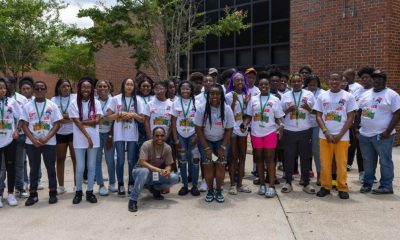Technology
Lenovo Shipped Laptops with Security Flaw, Experts Say
BRANDON BAILEY, AP Technology Writer
SAN FRANCISCO (AP) — If you’ve recently purchased a laptop computer made by Lenovo, you may want to hear this: Experts say the world’s biggest computer maker shipped laptops with pre-installed software that could let hackers steal passwords or other sensitive information when you use the web to shop, pay bills or check email.
Lenovo said Thursday that it has disabled the offending software, known as Superfish, and will provide customers with a tool that permanently removes the program from their computers. The company initially said its own investigation didn’t find “any evidence to substantiate security concerns.” But it later removed that sentence from a statement on its website.
The problem affects an unknown number of computers: Lenovo said it shipped “some” laptops with Superfish between September and December last year, before it stopped because of customer complaints. That could cover a large number of machines. Lenovo shipped more than 16 million laptop and desktop machines in the fourth quarter.
Superfish wasn’t intended as malware. Lenovo has said it was designed to show targeted ads by analyzing images of products that a user might see on the web and then presenting “identical and similar product offers that may have lower prices.” Lenovo said the software doesn’t track users or collect any identifying information.
But some users initially complained the software shows unwanted “pop-up” ads. And this week, several independent experts reported that Superfish works by substituting its own security key for the encryption certificates that many websites use to protect users’ information. “This means that anyone affected by this adware cannot trust any secure connections they make,” researcher Marc Rogers wrote on his blog.
What’s worse, experts said, is that Superfish appears to re-use the same encryption certificate for every computer, which means a hacker who cracked the Superfish key could have broad access to a variety of online transactions. Robert Graham, chief executive of Errata Security, boasted in a blog post Thursday that he was able to figure out the Superfish encryption password in a few hours.
So far, there’s been no evidence that hackers have used the vulnerability to steal information. To do that, some experts said, a hacker would probably need to search for owners of laptops that have the Superfish software and are using a public Wi-Fi connection to visit secure websites.
But some critics blasted Lenovo for acting irresponsibly by installing the software. “Lenovo has not just injected ads in a wildly inappropriate manner, but engineered a massive security catastrophe for its users,” said the Electronic Frontier Foundation, an Internet advocacy group, in a blog post Thursday.
Superfish is made by a tech startup based in Silicon Valley and Israel. A spokesperson wasn’t immediately available for comment.
Many PC-makers ship computers with pre-loaded software from other companies, often in exchange for commissions or fees. Lenovo said its arrangement with Superfish is “not financially significant.” The company said it stopped selling laptops with the program in January and added: “Our goal was to enhance the experience for users; we recognize that the software did not meet that goal and have acted quickly and decisively.”
“We’re not claiming it wasn’t a mistake,” Lenovo spokesman Brion Tingler added Thursday. “We do due diligence and it wasn’t good enough in this case.” He added that the company is reviewing its procedures.
While Lenovo says it stopped shipping computers with Superfish in January, some may still be in stock at retailers. Lenovo posted detailed instructions for removing the software and the Superfish encryption certificate from its computers. They can be found at: http://news.lenovo.com/images/20034/remove-superfish-instructions.pdf
Copyright 2015 The Associated Press. All rights reserved. This material may not be published, broadcast, rewritten or redistributed.
Activism
Self-eSTEM Empowers BIPOC Women, Girls in Science, Math
In January 2025, Self-eSTEM will launch digital and generative AI programming, which provides digital literacy and AI literacy training through an entrepreneurial project-based activity. This programming will be a hybrid (i.e. in-person and online). Additionally, thanks to a grant from Comcast, in spring 2025, the organization will have a co-ed series for middle and high school students.

By Y’Anad Burrell
Special to The Post
In a world where technology plays an increasingly central role in all aspects of life, the importance of Science, Technology, Engineering, and Math (STEM) education cannot be overstated. Recognizing the significance of STEM for the future, focusing on young women and girls is a critical step in achieving gender equality and empowering the next generation.
Self-eSTEM, an Oakland-based non-profit organization, was founded by Adamaka Ajaelo, an Oakland native who had a successful corporate career with several Bay Area technology and non-tech companies. Ajaelo boldly decided to step away from these companies to give 100% of her time and talent to the non-profit organization she started in 2014 in the belief that she can change the game in innovation and future STEM leaders.
Over the course of a decade, Ajaelo has provided futurist tech programming to more than 2,000 BIPOC women and girls. The organization has an Early STEM Immersion Program for ages 7-17, Emerging Leaders Workshops for ages 18-25 and volunteer network opportunities for ages 25 and up.
In January 2025, Self-eSTEM will launch digital and generative AI programming, which provides digital literacy and AI literacy training through an entrepreneurial project-based activity. This programming will be a hybrid (i.e. in-person and online). Additionally, thanks to a grant from Comcast, in spring 2025, the organization will have a co-ed series for middle and high school students.
While the organization’s programs center on innovation and technology, participants also gain other valuable skills critical for self-development as they prepare for a workforce future. “Self-eSTEM encourages young women to expand on teamwork, communication, creativity, and problem-solving skills. The organization allows young women to enter STEM careers and pathways,” said Trinity Taylor, a seventh-year innovator.
“Our journey over the last decade is a testament to the power of community and opportunity, and I couldn’t be more excited for what the future holds as we continue to break barriers and spark dreams,” said Ajaelo.
“By encouraging girls to explore STEM fields from a young age, we foster their intellectual growth and equip them with the tools needed to thrive in a competitive global economy,” Ajaelo says.
Empowering young girls through STEM education is also a key driver of innovation and progress. When young women and girls are encouraged to pursue careers in STEM, they bring unique perspectives and problem-solving approaches to the table, leading to more diverse and inclusive solutions. This diversity is crucial for driving creativity and pushing boundaries in scientific and technological advancements.
Self-eSTEM has fundraising opportunities year-round, but year-end giving is one of the most critical times to support the program. Visit www.selfestem.org to donate to the organization, as your generosity and support will propel programming support for today’s innovators.
You will also find more details about Self-eSTEM’s programs on their website and social channels @selfestemorg
Antonio Ray Harvey
Feds: California Will Be Home to New National Semiconductor Technology Center
California was chosen by the U.S. Department of Commerce (Commerce) and Natcast, the operator of the National Semiconductor Technology Center (NSTC) to be home to the headquarters for the National Semiconductor Technology Center – as part of the Biden-Harris Admin’s CHIPS and Science Act. The CHIPS for America Design and Collaboration Facility (DCF) will be one of three CHIPS for America research and design (R&D) facilities and will also operate as the headquarters for the NTSC and Natcast.

By Antonio Ray Harvey
California was chosen by the U.S. Department of Commerce (Commerce) and Natcast, the operator of the National Semiconductor Technology Center (NSTC) to be home to the headquarters for the National Semiconductor Technology Center – as part of the Biden-Harris Admin’s CHIPS and Science Act.
The CHIPS for America Design and Collaboration Facility (DCF) will be one of three CHIPS for America research and design (R&D) facilities and will also operate as the headquarters for the NTSC and Natcast.
“We are thrilled that the Department of Commerce and Natcast chose to locate this critically important facility in Sunnyvale, the heart of the Silicon Valley, alongside the world’s largest concentration of semiconductor businesses, talent, intellectual property, and investment activity,” said Dee Dee Myers, Senior Economic Advisor to Gov. Gavin Newsom and Director of the Governor’s Office of Business and Economic Development (GO-Biz). “The Newsom Administration and our partners across the industry know how important it is to shorten the timeframe from R&D to commercialization.”
According to GO-Biz, the DCF is expected to direct over $1 billion in research funding and create more than 200 employees in the next decade. The facility will serve as the center for advanced semiconductor research in chip design, electronic design automation, chip and system architecture, and hardware security. The CHF will be essential to the country’s semiconductor workforce development efforts.
As detailed in the released NSTC Strategic Plan, the DCF will suppress the obstacles to “semiconductor prototyping, experimentation,” and other R&D activities that will enhance the country’s global power and leadership in design, materials, and process innovation while enabling a vigorous domestic industr“Establishing the NSTC headquarters and design hub in California will capitalize on our state’s unparalleled assets to grow a highly skilled workforce and develop next-generation advancements,” stated U.S. Sen. Alex Padilla (D-Calif.). “This CHIPS Act funding will propel emerging technologies and protect America’s global semiconductor leadership, all while bringing good-paying jobs to our state.”
Community
Advanced Conductors Provide Path for Grid Expansion
Utility companies in the United States could double electric transmission capacity by 2035 by replacing existing transmission lines with those made from advanced materials, according to a new study published Monday in the Proceedings of the National Academy of Sciences.

By Matthew Burciaga
UC Berkeley News
Utility companies in the United States could double electric transmission capacity by 2035 by replacing existing transmission lines with those made from advanced materials, according to a new study published Monday in the Proceedings of the National Academy of Sciences.
Led by Duncan Callaway, professor and chair of the Energy and Resources Group (ERG), and Amol Phadke, an affiliate and senior scientist at the Goldman School of Public Policy, the first-of-its-kind study details a faster and more cost-effective way to expand the grid and connect the more than 1,200 gigawatts of renewable energy projects awaiting approval. The analysis was first published last December as a working paper by the Energy Institute at Haas and has been covered by the New York Times, the Washington Post, Heatmap News, and other news outlets.
“Expanding transmission capacity is critical to decarbonization, and we sought to study ways to build it faster and cheaper,” said Callaway.
It currently takes 10 to 15 years to build a new power line and the U.S. is building transmission lines at a lower rate than it was in the past decade. Without sufficient capacity, renewable energy projects often sit in limbo for years as transmission operators study what upgrades—if any—are needed to accommodate the increased loads.
The authors modeled various scenarios to determine if replacing existing transmission conductors with those made with advanced composite-core materials—a process known as reconductoring—could provide a pathway to faster grid expansion.
Several reconductoring projects have been initiated in Belgium and the Netherlands, and utility companies in the U.S. have used the material to string transmission lines across wide spans like river crossings. That technology, however, has not made its way to the majority of overhead power lines that feed residential and commercial customers.
“As we learned more about the technology, we realized that no one had done the detailed modeling needed to understand the technology’s potential for large-scale transmission capacity increases,” said Phadke.
Based on the authors’ projections, it is cheaper—and quicker—for utility companies to replace the 53,000 existing transmission lines with advanced composite-core materials than it is to build entirely new transmission lines.
They assert that doing so would reduce wholesale electricity costs by 3% to 4% on average—translating to $85 billion in system cost savings by 2035 and $180 billion by 2050.
“The level of interest we’ve received from federal and state agencies, transmission companies and utilities is extremely encouraging, and since our initial report, the Department of Energy has committed hundreds of millions of dollars to reconductoring projects,” said co-author Emilia Chojkiewicz, a PhD student in ERG and an affiliate of the Goldman School of Public Policy. “We are looking forward to learning about these projects as they unfold.”
Additional co-authors include Nikit Abhyankar and Umed Paliwal, affiliates at the Goldman School of Public Policy; and Casey Baker and Ric O’Connell of GridLab, a nonprofit that provides comprehensive technical grid expertise to policy makers and advocates.
-

 #NNPA BlackPress4 weeks ago
#NNPA BlackPress4 weeks agoTarget Takes a Hit: $12.4 Billion Wiped Out as Boycotts Grow
-

 Activism4 weeks ago
Activism4 weeks agoUndocumented Workers Are Struggling to Feed Themselves. Slashed Budgets and New Immigration Policies Bring Fresh Challenges
-

 Activism4 weeks ago
Activism4 weeks agoOakland Post: Week of February 26 – March 4, 2025
-

 #NNPA BlackPress4 weeks ago
#NNPA BlackPress4 weeks agoBREAKING Groundbreaking Singer Angie Stone Dies in Car Accident at 63
-

 #NNPA BlackPress4 weeks ago
#NNPA BlackPress4 weeks agoNAACP Legend and Freedom Fighter Hazel Dukes Passes
-

 Arts and Culture4 weeks ago
Arts and Culture4 weeks agoBeverly Lorraine Greene: A Pioneering Architect and Symbol of Possibility and Progress
-

 #NNPA BlackPress4 weeks ago
#NNPA BlackPress4 weeks agoTrump Kicks the Ukrainian President Out of the White House
-

 #NNPA BlackPress4 weeks ago
#NNPA BlackPress4 weeks agoApple Shareholders Reject Effort to Dismantle DEI Initiatives, Approve $500 Billion U.S. Investment Plan


























































